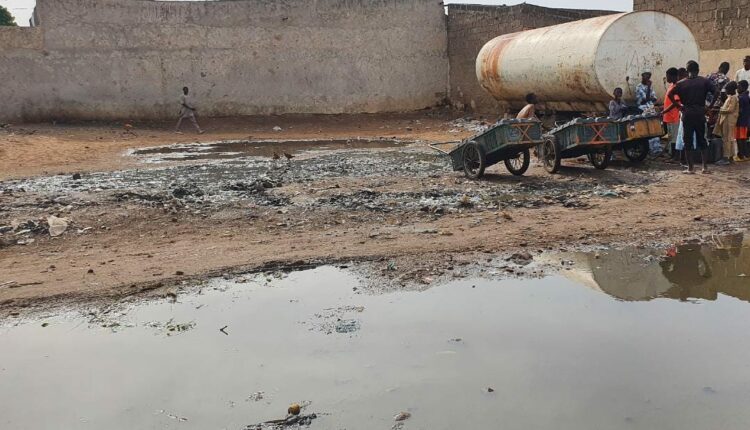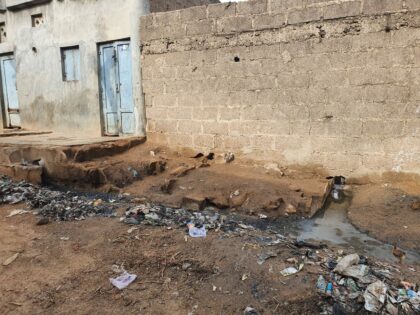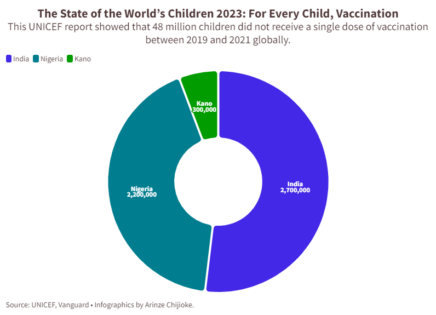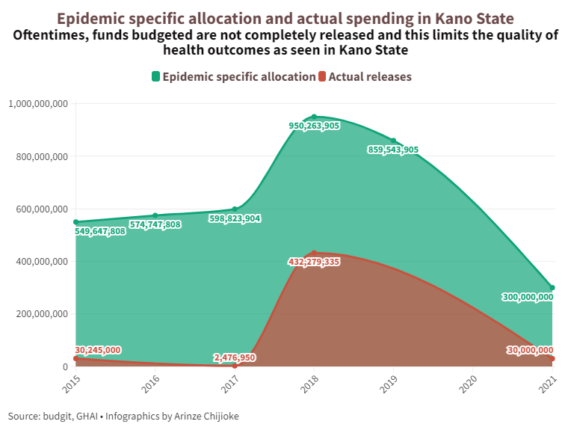On January 20, the Nigeria Centre for Disease Control (NCDC) announced that there had been an outbreak of diphtheria in Nigeria.
First noticed in Lagos and Kano State on December 1, 2022, the outbreak was described as the worst in a decade.
Solacebase.com, an online Nigerian newspaper, would in the course of its investigation, identify Kano State as the epicentre of the recent outbreak.
READ ALSO: Investigation Reveals How Potable Water Scarcity Kills, Maims Kogi Citizens
SEVEN-YEAR-OLD WITH A RUNNY NOSE

When seven-year-old Musab Kabir had a runny nose, fever, constant headaches and sore throat in April, he complained to Kabir senior, his father.
Without wasting time, the older Kabir rushed his son to a primary healthcare centre (PHC) in the Ungogo Local Government Area of Kano State.
“At the hospital, they did not carry out any test but gave us some medication and said it would help to calm him down. They asked us to go home,” said the older Kabir.
On returning home, the seven-year-old’s condition got worse, forcing his father to rush him to the Murtala Muhammad Specialist Hospital (MMSH), where they ended up spending three days on admission.
While at the specialist hospital, a diphtheria test was carried out, and the result came out positive.
READ ALSO: ‘We Were Not Involved’ — Anambra Govt Disowns Arrows of God Orphanage
Diphtheria antitoxin (DAT) was eventually administered to the victim to stop the bacteria toxin from further damaging his body. After this, he was also given some antibiotics to help eliminate the bacteria and prevent transmission to others.
ANOTHER CHILD IS ILL
As the younger Kabir was being attended to at the hospital, the older Kabir returned home to discover that Fatima, his four-year-old sister, was displaying the same symptoms.
Sadly, he could not take her to the specialist hospital for treatment that same night because it was late and the hospital was quite far from his community.
To make matters worse, the primary healthcare centre in his community lacked the capacity to treat diphtheria.
And so, he decided to wait till the next morning to take her to the hospital for treatment. Unfortunately, Fatima died that night.
“My daughter would not have died if our community health centre could handle the disease,” Kabir senior lamented.
“There was no way we could get medication for her the night she died.”
Fatima was one of many children who have died following the outbreak of diphtheria in Kano State. The lack of access to healthcare in remote and underserved areas has made it difficult to detect and treat diphtheria cases early, and this has led to further transmission and more deaths.
DIPHTERIA, A DEADLY BACTERIA INFECTION
Diphtheria is a bacteria infection which is transmitted through respiratory secretions or by breathing in droplets from an infected person when they cough or sneeze. The symptoms include fever, runny nose, sore throat, cough, neck swelling and so on.
According to the NCDC, a thick grey or white patch appears on the tonsils and/or at the back of the throat associated with difficulty in breathing in severe cases.
Health experts say most infections do not show symptoms or are mild. For those that do, symptoms usually start two to five days after a person becomes infected.
Diphtheria can be passed from one person to another through close contact, respiratory droplets or contaminated items. The disease can be fatal, but treatment with antibiotics and antitoxins can save lives.
“If the toxin gets into the bloodstream, it can cause heart, nerve and kidney damage. Where the disease is coupled with poor hygiene, infection of the skin is also common, leading to pus-filled blisters, including on the legs and hands,” a report by the US Centre for Disease Control and Prevention (CDC) reads.
DEATH TOLL
As of January 2023, the Kano State Ministry of Health confirmed that 25 persons, mostly children, had been killed following the outbreak.
As of March 15, Kano State alone had 377 cases out of the 389 confirmed cases across 21 states.
According to a situational report from the National Centre for Disease Control (NCDC), this translated to 44.7 percent and 56 deaths out of every 62 recorded nationwide.
DEARTH OF HEALTH CARE FACILITIES IN KANO
Only Aminu Kano Teaching Hospital (AKTH) and the Murtala Muhammad Specialist Hospital (MMSH) have the facilities and capacity to manage victims.
READ ALSO: ARROWS OF GOD: One of Nigeria’s Biggest Orphanages Is Trading Babies for Cash
All other health facilities in the state cannot treat victims because they do not have the capacity to do so.
A research carried out to establish the accessibility of doctors in Kano State has also shown that fewer than that just one doctor is expected to be responsible for the treatment of 10,000 persons.
This is way below the Sustainable Development Goal (SDG) target of 44.5 doctors, nurses and midwives per 10,000 persons.
CROWDED ENVIRONMENT AND POOR SANITATION CONTRIBUTE TO SPREAD OF DIPHTHERIA

The NCDC has described people who live in a crowded environment and those who live in areas with poor sanitation as being susceptible to contracting and spreading the disease.
In most rural communities in Kano, the neglect of continuous sanitation exercise and siting of adequate sanitation facilities prevail. Soak-away pits and gutters overflowing with dirty water around residential areas are also common in such areas.
Most worrying is the fact that children are often seen playing around these environments. It is also common to see both adults and children squatting and defecating into trenches and pools of water.

In 2021, the state government declared a state of emergency on Water, Sanitation and Hygiene (WASH) so as to end open defecation.
It also pledged to provide mobile toilets and more public conveniences in the state. Regrettably, these commitments never materialised as anticipated. In addition, access to safe drinking water is a major challenge in these rural areas.
When the inhabitants of the area sometimes purchase water from water vendors, they are supplied with water from jerrycans that have not been cleaned for months. This easily aids the spread of of germs and bacteria.
“Because of the scarcity, we just want water and don’t care where it is coming from,” Abdulhamid Muhammed, the community head of Gwagwarwa, a rural settlement in Nassarawa Local Government Area of the state, told Solacebase.
“We believe that provided it is borehole water, it is drinkable. Oftentimes, if their pipe falls inside dirty water or on the ground, they pick it up without washing it and continue to fetch.”
INADEQUACY OF VACCINES

While the Kano State government has made some efforts following the outbreak to curb the spread of diphtheria, the inadequacy of vaccines remains a challenge.
Presently, parents are having to depend on traditional herbs such as moringa powder, baobab and hibiscus leaves to treat their children and this has not been effective, according to Solacebase.
The Nigeria childhood immunisation schedule recommends three (3) doses of pentavalent vaccine (diphtheria toxoid-containing vaccine) which protects against 5 life-threatening diseases – Diphtheria, Pertussis, Tetanus, Hepatitis B and Hib – in children in the 6th, 10th and 14th week of life.
However, inadequate vaccination coverage has been identified as another major driver of the outbreak in Kano. The state’s child vaccination rates are well below both the national average and the target/world average.
At a webinar organised by the NCDC in March, Salma Ali Suwaid, the Head of the emergency paediatric unit at the Murtala Mohammed Specialist Hospital in Kano, said that only 20 per cent of children aged four to 14 were fully vaccinated with tetanus and diphtheria vaccines in the state.
She further said that ten per cent were partially vaccinated and 54 per cent were not vaccinated.
Dr. Aminu Ibrahim Tsanyawa, a former health commissioner in the state, said that the low routine immunization responsible for the spread of the disease was due to the hard-to-be-reached areas in the state.
In its child vaccination report released in April, the United Nations International Children’s Emergency Fund, (UNICEF) stated that Nigeria had 2.2 million unvaccinated children between 2019 and 2021. It was further established that, out of this number, an estimated 300,000 children were unvaccinated in Kano State.
FORCED TO SUPPLY VACCINES MEANT FOR PREGNANT WOMEN

Bassey Okposen, the Director of Disease Control and Immunisation at Nigeria’s National Primary Health Care Development Agency (NPHCDA), recently said 500,000 doses of Tetanus and diphtheria (TD) vaccines had been supplied to Kano State for the vaccination of children between the age bracket of four and 14 years.
The agency, however, also pointed out that it had to supply the vaccine stock meant for pregnant women to Kano State because of the critical state of things there.
For the adequate medical management of cases, the World Health Organization (WHO) recommends that sufficient quantities of diphtheria antitoxin should be available nationally or regionally.
Across Dala, Gwale, Tarauni, Nassarawa and Ungogo — the five local governments which are the epicentres of the outbreak, only 160,296 persons were reached with the 500,000 doses that were administered, according to data from the NPHCDA.
The sad part, however, is that, the five local government areas have an estimated population of 1,009,611. This means the vaccination exercise had not been impactful.
HUGE ALLOCATION, POOR RELEASES

Over the years, Kano State has grown its health budget share, especially concerning epidemic preparedness in line with increased prioritization and the need to invest significantly to improve its poor health metrics, according to Solacebase.
Its health budget rose from single-digit figures to double digits and exceeded the 15 percent mark to which several nations (Nigeria included) committed in the Abuja declaration of 2010 in 2019 and 2020.
However, findings show that the allocations have often not been completely released and utilised, leading to few results. In 2015, for instance, the state allocated N549,647,808 to epidemic preparedness but released N30,245,000.
In 2016, 574,747,808 was allocated but nothing was released. In 2017, N598,823,904 was allocated, but only N2,476,950 was released.
Out of N950,263,905 that was allocated in 2018, N432,279,335 was released. In 2019, N859,543,905 was allocated but no amount was released.
In 2020, the state created the Epidemic Preparedness and Response (EPR) budget line for fiscal year 2021, with funding increased by 33 percent for fiscal year 2022. The budget was over N400 million (US $960,000).
Separately, the 44 local government areas (LGAs) in the state also allocated N2 million each to strengthening EPR-related activities, increasing EPR spending by N88 million. This was followed by advocacy by the Legislative Advocacy Initiative for Sustainable Development Goals (LISDEL) and Global Health Advocacy Initiative (GHAI).
Out of a total of N300m budgeted for epidemic preparedness in 2021, N30m was approved and released by Abdullahi Ganduje, the then state governor, on August 2, 2021.
READ ALSO: Black Axe Lieutenant and Recruiting Sergeant Caught With Murder Video in Ireland
The Budget research also found that untimely and incomplete release of available funds limits the quality of outcomes which relevant agencies can accomplish within the intended fiscal time frame.
Solacebase produced the report with support from the Wole Soyinka Centre for Investigative Journalism (WSCIJ) under the collaborative Media Engagement for Development, Inclusion and Accountability project (CMEDIA) funded by the MacArthur Foundation.
Subscribe
Be the first to receive special investigative reports and features in your inbox.















